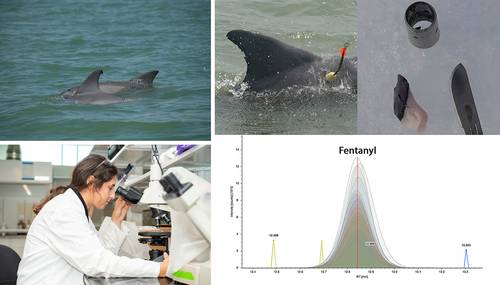Marine pollution from drugs is a global problem, researchers warn
The discovery of traces of fentanyl and other drugs for human use in free-swimming bottlenose dolphins in the Gulf of Mexico is relevant because these cetaceans are considered key bioindicators of ecosystem health and could signal risks for communities that depend on the sea. said researchers at Texas A&M University-Corpus Christi (TAMU-CC).
The study Drugs present in the fat of live, free-swimming common bottlenose dolphins analyzed 89 samples obtained by biopsy from 83 live animals and six from deceased specimens. The animals examined came from three sites: Redfish Bay, Laguna Madre in Texas, and 12 historic Mississippi Strait dolphin tissue samples from 2013.
In interview with The DayMakayla Guinn, a doctoral student at Texas A&M University-Corpus Christi, explained that this project began in 2020, after the discovery of a bottlenose dolphin stranded in Baffin Bay, Texas. We used the tissue from this animal to perform an analysis that allowed us to have a profile of all the compounds present.
he added.
Although the first tests did not detect pharmaceutical products, other analytical standards made it possible to identify and quantify opioids, muscle relaxants and sedatives in 40 percent of the samples collected.
The case of fentanyl stands out, an opioid analgesic 100 times more powerful than morphine, which was detected in 18 of the live animals and in all samples of dead specimens. Even though the concentrations found were sublethal, the researchers warn that even in small quantities this compound could have negative effects.
Guinn said the research team has several hypotheses about how fentanyl got into the marine ecosystem and ended up in these animals. “We know that humans consume medications daily, which can often be flushed down the toilet or drain.
Upon reaching wastewater treatment plants, treatment processes are not always 100 percent effective in processing these compounds before they enter the environment. We often find traces of these substances in recycled water or in the environment, in our rivers and streams, and finally the marine environment.
.
The scientist commented that Another possibility is that, because these populations live in areas near busy ports with a lot of maritime activity, where these products may have been thrown overboard or transported from various locations around the world
.
Dara Orbach, associate professor of Marine Biology and member of the project, recalled in an article published by TAMU-CC that the discovery of the dead dolphin in Baffin Bay occurred a year after a historic liquid fentanyl raid in the neighboring county.
Both specialists agree that drug contamination is not a local problem, but a global concern. They warn that in one way or another, these compounds reach the marine environment and have effects on wildlife.
consulted by The DayAnya Isabelle Ocampos, candidate for a doctor of veterinary medicine and member of the research team, warned that the contaminants could reach humans through the food chain. Since cetaceans likely acquire these substances through ingestion of their prey, it is possible that fishermen and communities that consume large quantities of fish and shrimp may also be exposed to or indirectly ingest drugs through shellfish and contaminated drinking water.
.
Although the specific risks to humans are not yet fully understood, Ocampos stressed the importance of being alert: Basically, as predators at the bottom of the food chain, there is a chance that we are also consuming these contaminants secondarily. It is important that people are aware of this evidence
.
Regarding the impact of contamination by fentanyl and other medications on the ecological balance of the Gulf of Mexico, the scientist mentioned that “research on the presence of these compounds in cetaceans is limited.
There are very few analyses, one of them was carried out on dolphins stranded on the coast of France, in the Bay of Biscay, where they found some elements of this type and were able to quantify them.
He added that in the case of fentanyl It has never been found in a dolphin before, nor am I sure other opioids have been found in cetaceans.
.
Guinn, Ocampos and Orbach agreed that drug contamination is a global problem, and it is not surprising that these compounds can be present in various populations around the world.
This discovery is the beginning of a crucial field of study to understand the potential consequences, not only for marine ecosystems, but also for the people who depend on them.
Guinn indicated.
Orbach emphasized that Proactive monitoring of these emerging contaminants is necessary, especially in regions with large human populations and fishing activities.
.
With this call, the researchers hope that the results will prompt further exploration into the long-term effects of pharmaceutical pollution on marine life and the health of ecosystems in the Gulf of Mexico.
